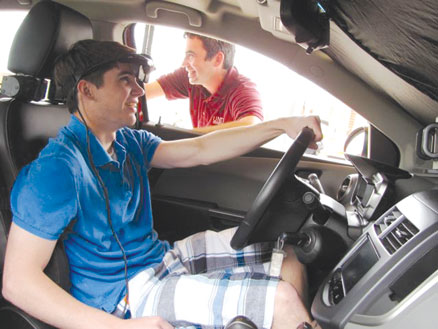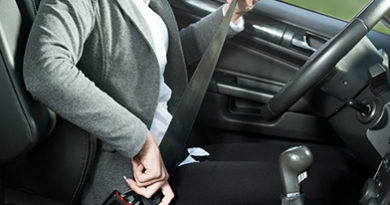High-tech exhibits highlight auto show
CHARLESTON, W.Va. – Michael Burns is only 12 years old, but Sunday he got to spend a few minutes behind the wheel of a car, driving along a main street crowded with cars and pedestrians.
Not to worry, though, it was all simulated – part of an exhibit at the West Virginia International Auto show this weekend at the Charleston Civic Center. The exhibit let people get behind the wheel of a real car, look through a pair of goggles and try to navigate the roads while typing and sending text messages.
Onlookers could track their progress from a screen mounted outside the car’s window. They saw the same thing the participant did through the goggles: a view of the road.
Burns started off OK, quickly getting the feel for the car. But then an assistant instructed him to pick up a cellphone in the seat next to him and type, “Call you back, I’m driving.” That’s when he started having trouble.
The car lost speed as he started typing, and then gained too much speed too quickly, breaking the 45-mile-per-hour speed limit, as he tried to compensate. He swerved between lanes, nearly hitting a cab on his right, and then crossed over the double yellow lines in the center of the road.
Finally, he crashed, hitting a pedestrian in a crosswalk.
Burns got out of the car shaking his head, and Storn Olson, the instructor who was leading Burns through the exercise, handed him a ticket listing his driving violations and walked him through what he’d done wrong.
“If you’d done that for real, they’d have stuck you with a real rotten charge,” Olson said. “You could be charged with negligent homicide for that.”
Other volunteers swerved into oncoming traffic or ran off the side of the road, but none of them could type and send a text message without leaving their driving noticeably, dangerously, impaired.
As he took Burns’s photo and printed it onto a souvenir keychain, Olson told him about the laws surrounding texting while driving (a West Virginia law allowing police to stop anyone they see with a phone in their hand goes into effect this summer) and the inherent dangers that accompany distracted driving (more than 3,000 people died in 2011 from accidents directly related to texting while driving).
Burns left laughing, but sure that when it’s time for him to drive, he won’t text behind the wheel.
“I’m not going to risk a couple thousand dollars in damage to my car just for a text message, or kill someone,” he said. “No way will I do that.”
It was a popular event at the auto show, keeping the attention of a small crowd of people throughout the three-day auto show. Plenty of adults took part, but many of the volunteers were so young they haven’t gotten their drivers’ licenses yet.
Olson said that’s part of the point of the exercise: they lure kids in with the 3D simulation technology and the chance to get behind the wheel of a brand new car, and then show them firsthand how easy it is to lose control of a vehicle while they’re distracted, before they have the chance to make the mistake in real life.
“I mean, I remember my first car show and how excited I was,” he said. “If I’d gotten to do this driving simulation there, I would have remembered that lesson the rest of my life.”
The simulation was put on by the Arrive Alive™ Program with Unite, an organization that travels the country educating students on the dangers of distracted driving.




You must log in to post a comment.